It is one of the quirkier facts of Irish football that it took until June 2018 and Darragh Lenihan’s arrival on after 35 minutes for John O’Shea in the game against the USA before the record books said the county of Meath had produced an Irish senior international.
The expansion over the county border of Dublin’s suburbs should mean that number two is not quite so long coming but in the meantime there may be a generation of players who, when they line out for their country in the coming years, will look back and reflect on how that part of their story started there.
The lack of emerging options available to Martin O’Neill was again an issue this week as was the complicated nature of getting players not developed here to declare for the country. Then there is the proposal by the English FA that bringing overseas kids into club academies be totally banned, something that would dramatically alter the long established landscape for Irish football.
In the circumstances, there is a widespread acceptance that the FAI must play an increasingly central role in producing future generations of footballers. Under-15 is the youngest level the organisation fields an international team at and the latest incarnation of that side will gather in Dublin today before heading to Poland where, next Tuesday and Thursday, 18 young players will play for this country for the very first time.
The selection process started in earnest a year ago when 45 under-14s were gathered together for training camps. The net, says under-15 team manager Jason Donohue, is cast more effectively than ever. "It's more consistent than it has ever been," he says. "The network is better, there are more people watching better organised games." If the last few years are anything to go by, he suggests, those 45 will be the cornerstone of that age group as it develops.
Preparing players
Making that initial cut, though, guarantees nothing. It will be a decade before we can really say who amongst this group has “made it”. Of the 51 players capped at underage level to be born a decade earlier, in 1994, only two – Sean Maguire and Lenihan – have so far made it all the way to the Irish senior team.
As part of the process of preparing players and their parents for what lies ahead, the FAI invites them all to a briefing on the day the squad gathers for the first time. This is the Meath connection with Johnstown Estate, near Enfield, used for the event.
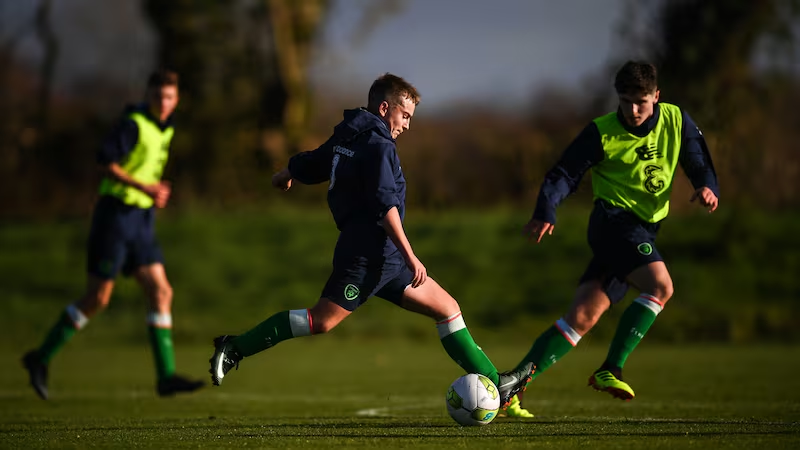
Most of the challenges likely to be encountered are touched upon by Donohoe or the other members of the coaching staff. Mark Evans, a nutritionist, talks about the importance of young players coming to regard food as fuel and as examples of suitable diets are displayed onscreen, the parents who are present – especially those with other kids to feed – might be forgiven for feeling that it is not only their teenage son who is going to have work harder if he is to be kept on course for a senior career.
The association's head of fitness, physiotherapist Dan Horan, then outlines the other big burning issue; the players' levels of physical strength and fitness. "How many players in the group have been over at a club in England for a trial?" he asks and a few tentative hands go up. "And how was the experience?" he asks before teasing out of a couple of slightly reluctant volunteers that, for all the novelty and nervousness and excitement, it was often incredibly tough going.
To illustrate the problem, Horan throws up a selection of Premier League weekly training schedules for kids the same age as the ones gathered here in the hotel function room. Perhaps the most striking involves three days on which there are sessions both on the pitch and in the gym, another with just pitch work plus the actual matchday. He talks about it all being possible because the clubs locate classrooms, catering and all of the sports facilities on the one site, rather like, he observes pointedly, the private rugby schools that have been so successful in developing elite level athletes for this country during that sport’s professional era.
Most schoolboy football clubs, on the other hand, have traditionally trained two or three times a week with a game at the weekend. The message is clear: our young players need to be doing more if they want to be able to impress when their opportunity comes knocking.
Best practice
“The training week in England, Spain, Germany, across Europe, would involve multiple training sessions, both on the pitch and in the gym,” he says afterwards, “and the question for us, and for the parents to ask themselves is ‘are we matching up to what is considered best practice over there?’”. Clearly, the answer expected is “no”. Better diet, bigger “training loads” and far more effective communication between those involved in the development of the young player are the key improvements generally required, he says.
Trials, he suggests, are tough enough without players finding themselves up against rivals who are already fitter and stronger. British clubs can then add considerably to the scale of the challenge by putting together hugely demanding schedules for kids coming over, ones often intended to suit academy coaches who want to see as much as possible of each player in the short time available rather than some desperately inexperienced trialist who finds that, by the time he tries to play a second game in three busy days, he is utterly exhausted.
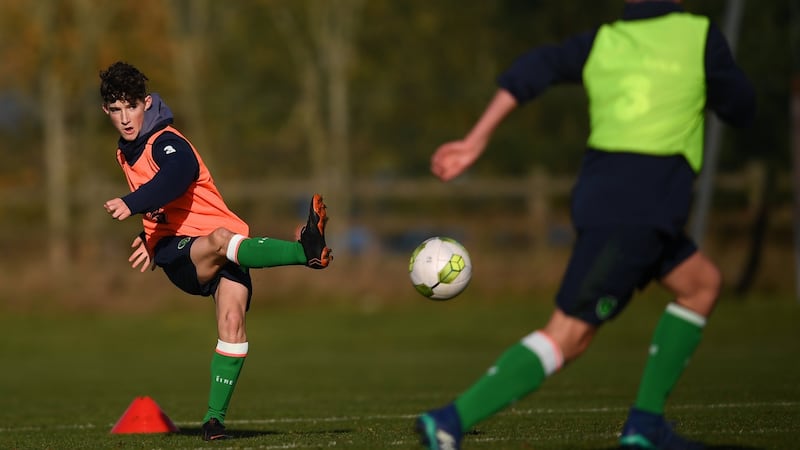
When Horan asks if any of the parents have ever looked for detailed itineraries or questioned the ones that have been provided, the only two fathers to speak up – Barry Ferguson and Pat Quinn – turn out to be rooted in the game.
“The clubs will jump on it if they think: ‘these are a bit green coming in,’” says Quinn, a brother of senior internationals, Alan and Stephen. “The likes of Barry and myself have been around, it’s in our DNA. I won’t be tipping around any club. He’s our son, we love him and we want the best for him and if things don’t seem right then I’m going to speak my mind.”
His son, Ben, a big, strong and clearly talented forward who has been playing at Cherry Orchard since he was four or five years old became the first player ever to score a hat-trick in the final of the Kennedy Cup this year. He has been on several trials, at Celtic and a few clubs in England and, despite being just 14, already has at least one offer of a professional contract when he turns 16.
Ferguson’s son, Evan, has been over to Manchester United, Liverpool and Everton and though there have been no actual offers, there is plenty of ongoing interest in a player who, like his father and many other family members before him, plays for St Kevin’s and featured alongside Quinn in this year’s successful Dublin and District Schoolboys League team.
“Myself and my wife (Sarah) would talk and we would have an idea what we would want for him,” says Barry who went to Coventry City after completing his Leaving Cert (“There wasn’t a queue of offers for me as a kid,” he says with a laugh) then came home after loan spells at Colchester, Hartlepool and Northampton to what was a good League of Ireland career and, ultimately, a job as a development officer with the FAI.
‘Off the wall’
“We want it to be a good experience, if there is an opportunity or somebody offers him something we want there to be something in it for him; not financial but an experience that, at the end of the week is something he is happy with.”
The trials he has been on, he says, have all been that but one of several others they declined, mainly due to the issue of school and holidays, involved a schedule that was, he says, “off the wall”.
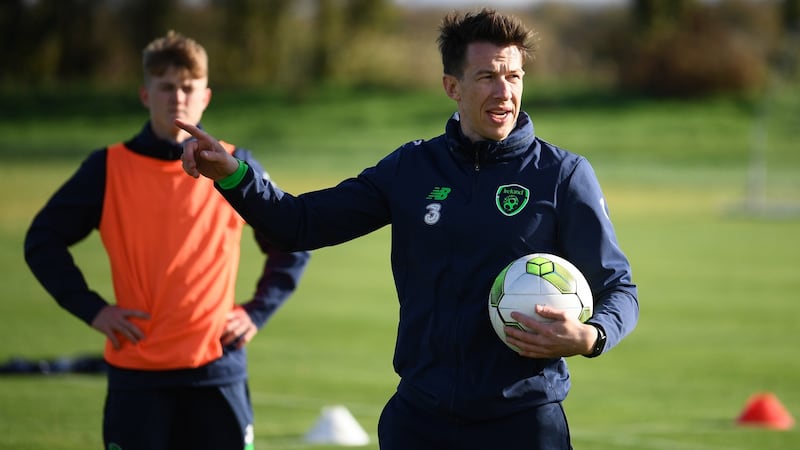
“If he continues to progress,” he says, “he will probably have the opportunity to go away but we don’t even know if he’s the right type of character to live away from home; that’s a very individual sort of thing.”
Donohue readily acknowledges all of the potential pitfalls but says the association’s system for monitoring and supporting the development of players has never been better.
Club structures have been transformed, national leagues introduced, more and better qualified coaches brought into the system. These are clearly all positive developments although it goes without saying that others have not been standing still and many countries across Europe, especially those with stronger leagues, are far ahead of Ireland – spending more and progressing faster.
Here, the coaches work hard to make the most of the resources they have – which is certainly more than was the case previously – and a lot of effort goes into getting the players to engage.
At the Johnstown House session the new players are equipped with a high level monitoring app, and briefed on how to use it so that the FAI’s coaches are up to speed on their progress and on any problems they might be encountering.
“It’s about building relationships so that together we can develop footballers,” says Donohoe of the weekend over the course of which he will meet at least one parent of all 18 players. “I think the pathway is getting much better although things outside of our control are obviously changing. When you talk about the Citys and Chelseas, the money no object level, they will just buy a player from absolutely anywhere in the world and that’s why there aren’t so many Irish players going over.
“Our players are doing really well over here but I think they need to be training three, four five times so that when they do get the chance to go over they can impress.
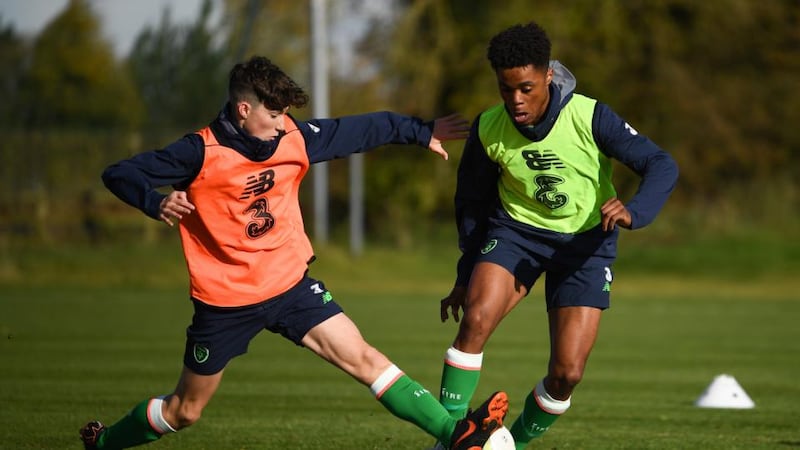
“The later they go over the better,” he continues. “Based on what a lot of the players who have gone over have gone through, it can be lonely going over at 16. They are better off being that little bit older, the little bit of education will help them and you can give them a driving license and a bit of independence at that stage. It all makes for an environment that can improve the chances of success.”
In the meantime, he and the other FAI coaches keep tabs on how they are doing at their schoolboy or League of Ireland clubs here. There is fairly regular contact with a group. The team will play a total of nine games over the season, Poland almost always come first as coaches from the two countries have developed close ties and each see benefits in their players kicking off against teams with the other’s attributes. The weekend ends with the Irish under-15s playing an under-16 side specifically set up to play the way Poland will. They win 3-1 and Donohoe describes them a particularly promising group.
Adaptation
Inevitably, though, the precise lineup will change over time with the different rates of physical and personal development making for quite a high level of chopping and changing between squads. Players sometimes disappear for a spell due to an intense period of growth that requires adaptation, other drift off for all sorts of reasons but Donohoe remains confident that the group will remain relatively constant through the coming years.
Paul Osam’s under-16 squad for the Victory Shield, announced last week, for instance, is substantially different to Donohoe’s first one of last year but there is, he says, just one player who was not on the radar then – Fulham’s English-born forward Oliver O’Neill.
The pressure of it all will ultimately account for a few of them although Quinn, who marvels at how these things have changed since he was along to a couple in his own playing days and saw all of their players training in their club gear, is happy to say that Ben is taking it in his stride so far.
“You need another out in life so we put a lot of emphasis on other things, on education obviously but also on the other small things, walking your dog or whatever and not being so uptight and tense when it comes to football. So this is not like a job to Ben.
“It’s a great time to be living,” he says, warming to the subject as his son and the others train together as part of an Ireland squad for the very first time a few yards away. “It’s a great time to live in. It’s a great country we live and what an opportunity these lads have: to be a soccer player, and go an embrace everything if they are talented enough to do it; to have the time of their lives.”
From intensive care to a World Cup
All manner of things can go wrong for a young player marked out at an early stage as a “prospect”. Kids routinely get injured, don’t develop physically in the way they would have hoped or simply lack the huge levels of application required. And sometimes it is all a bit more dramatic than that.
Charlie Fogarty had played a handful of international games for Northern Ireland when he was released by Birmingham City. Determined to get his dream of a professional career back on track he went on trial to MK Dons and was his way to training at the club in March of 2012 when he was hit by a car while crossing the road.
His parents were at the birthday party of his younger brother Tom when they got the news that he had been rushed to hospital.
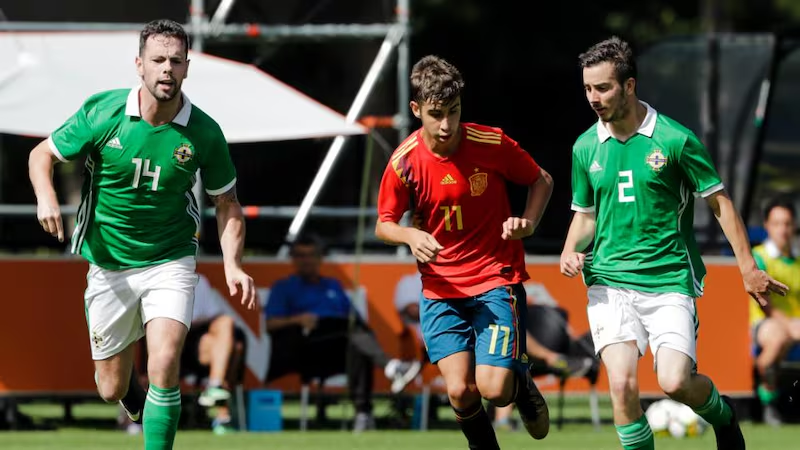
"We got there and he was having scans and after about an hour we got the news he was okay and we were allowed to see him," his father Mark, a football coach, told Barry Glendenning of the Guardian six months ago. "But what we didn't realise was that he was in intensive care. He actually wasn't okay. He was in a type of a coma. He wasn't doing anything and he remained not doing anything for four months."
The injuries Charlie sustained that day have profoundly affected his life since but his resilience has been astonishing. He has represented Northern Ireland in Cerebral Palsy World Cups and he spends a great deal of time talking to young players at clubs up and down England about the challenges he has faced the ways in which he has met them. He set up a club team for players with disabilities and at the start of this year, he was awarded an MBE for everything he has done since the accident.
At charliefogarty.co.uk he publishes a blog about his life and experiences. As the Irish under-15 squad gathered for the first time last month, he posted something for the kid whose birthday party had been cut short six years before: “Best of luck to my brother who flew over to Ireland on his own to play with Republic of Ireland. Go and make a name for yourself mate.”











